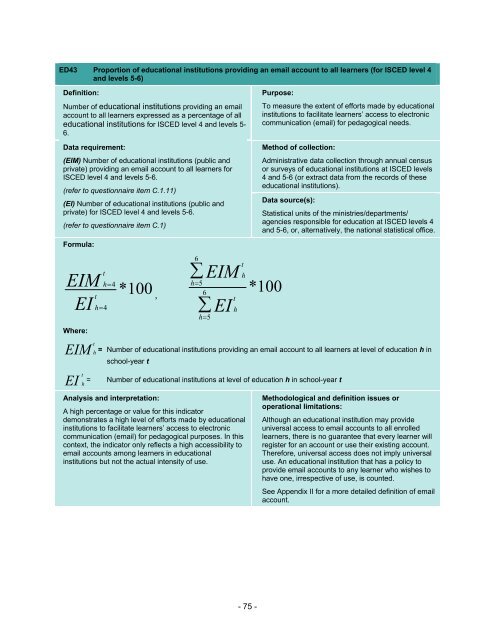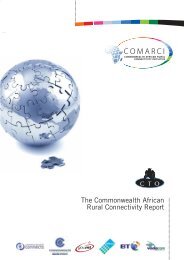Guide to measuring information and ... - unesdoc - Unesco
Guide to measuring information and ... - unesdoc - Unesco
Guide to measuring information and ... - unesdoc - Unesco
You also want an ePaper? Increase the reach of your titles
YUMPU automatically turns print PDFs into web optimized ePapers that Google loves.
ED43 Proportion of educational institutions providing an email account <strong>to</strong> all learners (for ISCED level 4<br />
<strong>and</strong> levels 5-6)<br />
Definition:<br />
Number of educational institutions providing an email<br />
account <strong>to</strong> all learners expressed as a percentage of all<br />
educational institutions for ISCED level 4 <strong>and</strong> levels 5-<br />
6.<br />
Data requirement:<br />
(EIM) Number of educational institutions (public <strong>and</strong><br />
private) providing an email account <strong>to</strong> all learners for<br />
ISCED level 4 <strong>and</strong> levels 5-6.<br />
(refer <strong>to</strong> questionnaire item C.1.11)<br />
(EI) Number of educational institutions (public <strong>and</strong><br />
private) for ISCED level 4 <strong>and</strong> levels 5-6.<br />
(refer <strong>to</strong> questionnaire item C.1)<br />
Formula:<br />
EIM<br />
t<br />
EI<br />
Where:<br />
t<br />
h4<br />
h4<br />
* 100<br />
,<br />
6<br />
EIM<br />
h5<br />
6<br />
EI<br />
h5<br />
t<br />
h<br />
t<br />
h<br />
- 75 -<br />
Purpose:<br />
To measure the extent of efforts made by educational<br />
institutions <strong>to</strong> facilitate learners’ access <strong>to</strong> electronic<br />
communication (email) for pedagogical needs.<br />
Method of collection:<br />
Administrative data collection through annual census<br />
or surveys of educational institutions at ISCED levels<br />
4 <strong>and</strong> 5-6 (or extract data from the records of these<br />
educational institutions).<br />
Data source(s):<br />
Statistical units of the ministries/departments/<br />
agencies responsible for education at ISCED levels 4<br />
<strong>and</strong> 5-6, or, alternatively, the national statistical office.<br />
* 100<br />
EIM t<br />
h = Number of educational institutions providing an email account <strong>to</strong> all learners at level of education h in<br />
school-year t<br />
EI t<br />
= Number of educational institutions at level of education h in school-year t<br />
h<br />
Analysis <strong>and</strong> interpretation:<br />
A high percentage or value for this indica<strong>to</strong>r<br />
demonstrates a high level of efforts made by educational<br />
institutions <strong>to</strong> facilitate learners’ access <strong>to</strong> electronic<br />
communication (email) for pedagogical purposes. In this<br />
context, the indica<strong>to</strong>r only reflects a high accessibility <strong>to</strong><br />
email accounts among learners in educational<br />
institutions but not the actual intensity of use.<br />
Methodological <strong>and</strong> definition issues or<br />
operational limitations:<br />
Although an educational institution may provide<br />
universal access <strong>to</strong> email accounts <strong>to</strong> all enrolled<br />
learners, there is no guarantee that every learner will<br />
register for an account or use their existing account.<br />
Therefore, universal access does not imply universal<br />
use. An educational institution that has a policy <strong>to</strong><br />
provide email accounts <strong>to</strong> any learner who wishes <strong>to</strong><br />
have one, irrespective of use, is counted.<br />
See Appendix II for a more detailed definition of email<br />
account.
















